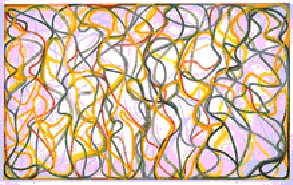Brice Marden MoMA Retrospective
by Robert Sievert, Diana Manister, and Juan Seoane Cabral
Robert Sievert:
I went last night to see the Mardens.... I was very
impressed with both the drawing and painting. His
use of line is mesmerizing. The lines dance around
the space in a loony way and end up
containing the space
The quality of the surfaces vary over the years what is so compeling is the technique he uses ... I think he must employ a lot of rubbing technique ... what else could account for that smooth burnished surface? I love the work and certainly wanted to in some way cover it but my mind was elsewhere.... so I got very excited when Diana Manister dropped these lines:
Diana Manister:
Happy New Year! Just wanted to say that I saw the Brice Marden show and thought his most recent work is exceptionally fine. There is a large greygreen painting with painterly outlines of figures discernible in it that is like a combo of a Pollock all-over and Nude Descending a Staircase.
A figure emerges in a kind of dancing pose, then disappears or appears to move into another position, and then moves again. Wonderful. The color and touch are beautiful too.
I like his monochromes too. Very waxy and soft. Especially the ones that leave a bare strip of canvas with paint drips along the bottom edge.
[ Diana didn't have the time to continue with her thoughts so it was even better when Juan Seoane Cabral wrote me: ]
Juan Seoane Cabral: Brice Marden. MoMA retrospective
Looking at Brice Marden's retrospective at MoMA, one may validly ask oneself if the implied gist of an art work can be subdued by its antagonistic adjective, the applied meaning.
The question of content was always in the studios of painters during the years in which Brice Marden started his career.
Dissatisfied by the relationship of subjects and representation, painters were about to explore into the fields of the linguistic possibilities of modernity, what it was once understood and consequently exposed by Clement Greenberg as "medium specificity", meaning by this that painters were now to look into the intrinsic mechanisms of paintings (gesture, color, surface) that makes painting an art in itself.
Throughout the exhibition, derivative connotations are subtly opposed to practical functions, as in Mr. Marden's work the viewer is a silent witness to the tensions between the extravagances and excesses of the Abstract Expressionism movement and its aftermath, Minimalist art, with its purified simplicity and its ascetic's forms, devoid of personality and mark-making.
Hence, in Marden's works, the gestural and expressionistic Jackson Pollock seems to meet an impersonal and muted Jasper Johns, in an opposite conjunction which tends to be both monotonous to the eyes of the untrained viewer and restrained for those who can claim some acquaintance in matters of painting.
Whether these differing appreciations can eclipse the career of a prestigious and consistent artist is not relevant in its peculiarity. What concerns us all is to understand and engage in an argument which is larger than the exhibition itself: the thesis that there are no intentions in an art work, only facts, and that it's in this bodily appearance that the art work comes alive as an event between the mental representation and its factual reality.
Marden is always aware of the times in which he is living and of the influences that are worth undertaking and making of its own. It's not difficult after reviewing the show to see his work divided in two vast enterprises, one for ascetic forms in the sixties and seventies and another one playful, almost careless, sensuous that comes from the eighties to the present time.
If we consider his work on paper "Untitled" (1972) we can see that it's not only the recently graduated student from Yale the one who is standing for an already known and standardized minimalist esthetic. In the works of other painters of the period like Agnes Martin or Robert Ryman we can see the necessity for a catalytic act, almost in a sense of sublimation and depuration; in the graphite and beeswax covered surface of Marden's drawing we can feel an act of masquerade and suppression.

"Untitled"- 1972. Graphite and bees wax on paper.
To which extent these works from the early years are a way of engaging himself in the arts of his time as a way of making personal his search for a new imagery or this primitive practices are just an attempt to place himself into the main stream is puzzling, if we consider that by those same years the first linear drawings which will give place to his signature style are already at birth. On the other hand, works like "Study for the muses (Hydra version)" are an account of the summit that an artist can reach once his has accomplished a level of maturity and of self confidence which leads to an autonomous gestural quintessence. There are ways of appreciating these newly conceived body of work that have little to do with the personal history of the artist and the historical time frame that he has lived in, and a lot more with the expressive possibilities of painting.

"Study for the Muses" (Hydra Version). 1991-95/1997. Oil on linen.
Here is where the linear, sumptuous shapes of primary colors creates a space for something more than a signature style, the paintings now lead the viewer to an aesthetic pleasure devoid of connotative derivations and for this reason they reach a level of universality within itself. Brice Marden is now, as an accomplished artist, creating a world, rather than making his interpretation of the world itself.
For this reason Brice Marden is raising issues that are beyond his body of work presented at MoMA, carrying with him the weight of an epoch, the Sixties, and somehow synthesizing the spirit of that age of disbelief and iconoclastic accounts and another one, the eighties, of newly gained joviality for the act of painting.
Text copyright © 2007 Juan Seoane Cabral
 back to Contents page
back to Contents page